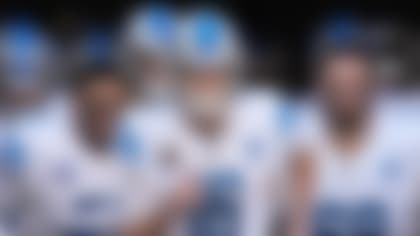Former NFL player and scout Bucky Brooks knows the ins and outs of this league, providing keen insight in his notebook. The topics of this edition include:
-- How running backs are central to a trend in team-building.
-- Despite offseason attrition, can the Ravens' defense live up to one player's HIGH billing?
But first, a look at the best defensive trios in the game today ...
* * * **
The wild-and-wacky NBA offseason undoubtedly has NFL executives thinking about their own roster-construction plans going forward. Although there are plenty of differences in the successful team-building models of each sport, there is a common denominator between star power and successful title runs.
In basketball, the "Big Three" approach has produced multiple title runs through the years, most recently for the Heat (LeBron James, Dwyane Wade and Chris Bosh) and Celtics (Paul Pierce, Kevin Garnett and Ray Allen) before them. And then the Warriors took it to another level, adding Kevin Durant to a unit that already included the "Splash Brothers" (Stephen Curry and Klay Thompson) and Draymond Green. Long story short: Most of the NBA's top teams over the last dozen years have featured multiple headliners on the marquee.
In football, the "Big Three" concept can be applied to both sides of the ball. Offensive triplets, which garner the vast majority of ink and interest, consist of a quarterback, running back and pass catcher. Meanwhile, defensive triplets feature a combination of three standouts from multiple levels of the unit, whether it be a pass rusher, linebacker and defensive back, or a couple of pass rushers and a designated playmaker in the back seven. The top teams have a set of triplets on each side of the ball with the capacity to dominate the game.
Earlier this week, my colleague Ali Bhanpuri ranked every team's offensive triplets, with the Saints, Chargers and Browns topping the board. The overall explosiveness of those top-tier units provides the teams with the capability to toss up 40-plus points in any game.
Defensively, the top trios not only have the potential to stifle passing games with a ferocious pass rush and/or airtight coverage on the perimeter, but they're capable of wreaking havoc on opponents with their collective speed, quickness and athleticism. Sparked by a triumvirate of dynamic defenders, defensive coordinators freely attack the opposition with a variety of pressure tactics that frustrate quarterbacks, suffocate perimeter playmakers and overwhelm offensive linemen.
With total domination of individual and collective battles serving as the standard, here are my top five defensive triplets heading into the 2019 season:
1) DE Joey Bosa, DE Melvin Ingram and S Derwin James, Los Angeles Chargers: Before you @ me on Twitter about the Bolts' standing atop the list, you should check out the unit's dominance the last half of the 2018 season after Bosa returned to the lineup. As a skilled rusher with outstanding hands and pass-rush skills, the former No. 3 overall pick bullies blockers off the edge, exhibiting a refined game that looks like it's pulled straight from a teaching video. Not to be outdone, Ingram flashes explosive pass-rush skills and a non-stop motor on the opposite side. Despite notching just seven sacks in 2019, Ingram's relentlessness off the edge leads to negative plays from a quarterback ill-equipped to deal with pressure. James gives the Bolts a bully between the hashes with the capacity to create chaos near the line of scrimmage or punish receivers venturing over the middle.
2) DE DeMarcus Lawrence, LB Jaylon Smith and LB Leighton Vander Esch, Dallas Cowboys: Rod Marinelli and Kris Richard have put their stamp on the Cowboys' defense with their lofty standard of play. The duo not only expects each and every defender to run to the ball with reckless abandon, but they demand that they do it while giving maximum effort on every snap. Lawrence is not only standard bearer on the defensive line with his non-stop motor and unremitting spirit, but he is a high-level performer boasting 25 sacks over the past two seasons. Smith and LVE match No. 90's intensity with a wolfpack mentality that allows the young, energetic defense to flex on opponents through the unit's collective speed, quickness and athleticism. With the Cowboys in position to potentially make a Super Bowl run sparked by their defense, we could see this unit vault to the top of the charts by the end of the season.
3) DL Akiem Hicks, LB Khalil Mack and S Eddie Jackson, Chicago Bears: Credit Chicago general manager Ryan Pace for going all in to acquire a dominant edge player who elevates the defense to elite status. Mack crushed opponents with his "bull in a china shop" playing style and dominant rush skills. In his first year with the Bears, Mack piled up 12.5 sacks, six forced fumbles, two fumble recoveries and a pick-six as the unit's designated playmaker. Hicks is Mack's Pro Bowl sidekick, with seven-plus sacks in each of the past three seasons. He is the perfect complement to Mack, as a destructive interior rusher with outstanding hands and combat skills. Jackson is a ball magnet in the secondary with superb instincts, awareness and range. He has eight interceptions in his first two NFL seasons, with three pick-sixes and a pair of scoop-and-score touchdowns.
4) DT Aaron Donald, LB Dante Fowler Jr. and CB Marcus Peters or S Eric Weddle, Los Angeles Rams: The back-to-back Defensive Player of the Year is arguably the best football player in the league. Donald sets the standard for the Rams' defense with his endless energy and freakish athleticism. He's unstoppable at the point of attack and opponents must account for his whereabouts on every single play. Fowler finally showed flashes of being a top-five draftee when he teamed up with Donald after a midseason trade. Fowler took his game up a notch in the playoffs, as evidenced by his 1.5 sacks and persistent pressure off the edges. Peters didn't bring his A-game in 2018, but still finished with three interceptions to push his career total to 22 picks in just four seasons. Considering the pressure the Rams should be able to generate with Donald and Fowler pushing the pocket, we could see No. 22 swiping passes left and right in 2019. And if Peters doesn't tickle your fancy, how about the savvy six-time Pro Bowl safety L.A. just scooped up in free agency?
5) LB Von Miller, LB Bradley Chubb and CB Chris Harris Jr., Denver Broncos: New Broncos coach Vic Fangio has spent the offseason salivating over the game-planning at his disposal with Miller and Chubb crashing off the edges. The Broncos' dynamic duo combined for 26.5 sacks and six forced fumbles in the team's previous scheme, and those numbers should only improve with Fangio's uncanny ability to create sack opportunities for pass-rush specialists. Harris is a crafty playmaker with the intelligence, versatility and instincts to make plays as a cornerback, nickel or safety in base or sub-packages. Given the impact of the pass rush on the effectiveness of coverage, Denver boasts one of the most feared threesomes in football.
Honorable Mention: DE J.J. Watt, LB Jadeveon Clowney and LB Benardrick McKinney, Houston Texans; DE Leonard Williams, LB C.J. Mosley and S Jamal Adams, New York Jets; DE Danielle Hunter, LB Anthony Barr and S Harrison Smith or CB Xavier Rhodes, Minnesota Vikings; DT Fletcher Cox, DE Brandon Graham and S Malcolm Jenkins, Philadelphia Eagles; DE Calais Campbell, LB Myles Jack and CB Jalen Ramsey, Jacksonville Jaguars.
TWO-POINT CONVERSION: Quick takes on developments across the NFL
1) New RB trend influencing team-building formula. Instead of bypassing talented runners in lieu of "value picks" in the mid-to-late rounds, savvy executives are using top picks to secure blue-chip RBs for their teams to provide stability and cost certainty at a position that remains valuable in the team-building formula.
Now, I know we've been conditioned to believe NFL running backs can be found at your local YMCA, but just look at the most recent first-round selections. You won't find many busts at the position. From Ezekiel Elliott (two-time NFL rushing champ) to Todd Gurley (2017 Offensive Player of the Year) to Christian McCaffrey (one of only three players with 1,000 rush yards and 100 catches in a single season) to Saquon Barkley (2018 Offensive Rookie of the Year and one of three rookies in history to surpass 2,000 scrimmage yards), first-round running backs are living up to the hype as playmakers for their respective squads. Additionally, they are centerpieces to an offensive puzzle who alleviate the pressure of a quarterback and enable some teams to play with a B or B+ player at the QB1 spot.
Given their overall importance to the majority of NFL offenses, it makes sense to draft running backs early and maximize their talents while they're still on team-friendly rookie deals. I know the football world typically views quarterbacks and their rookie contracts as one of the key components to building a championship team, but investing draft capital into a blue-chip running back could also become a pivotal part of the Super Bowl formula.
Before you scream bloody murder, hear me out when it comes to this theory.
Under the current terms of the NFL's collective bargaining agreement, teams have the option to exercise a fifth-year option on any player selected in the first round. By exercising the option, the team retains the rights of the player for an extra year on the standard four-year contract without needing to negotiate with the player. For players selected within the top 10, the fifth-year option is equal to the average of the top-10 salaries at the position. For players selected 11th through 32nd overall, the fifth-year option is equal to the average of the third through 25th highest salaries for the position from the previous year. This provides the team with cost certainty for five years while also giving the franchise the right to retain the player at the end of the five-year deal on a series of franchise tags that could keep a marquee running back in the fold for seven or eight years at reasonable prices.
That's why the Steelers were willing to string out Le'Veon Bell on a series of franchise tags at the end of his rookie contract instead of forking over big money on an extended deal that featured significant guarantees. It is also the reason the Dallas Cowboys could be slow-playing Ezekiel Elliott on an extension because they know they have him under contract for the next few years regardless of whether he likes it or not. It's also the ploy the Los Angeles Chargers could be using to take advantage of Melvin Gordon while he's in the prime of his career.
Looking at the Oakland Raiders' decision to give Josh Jacobsa fully guaranteed deal, it makes sense because his $11.8 million salary on a four-year term will look like a bargain if he turns out to be a Gurley-like playmaker for Jon Gruden's squad. Plus, the team will have an opportunity to keep him in the fold for a few extra years on a series of franchise tags that will likely take him through his prime years as a player.
The Patriots are notoriously frugal when it comes to players and compensation, yet they dropped a first-round pick on Sony Michel to anchor their running game. Is that a coincidence? I don't think so. Bill Belichick is typically at the forefront of the team-building trends, and the Patriots' decision to invest draft capital in a running back could signify a new way of doing business.
Keep in mind, Raiders general manager Mike Mayock enjoyed a solid relationship with Belichick when he worked with us at NFL Network. He could be following a blueprint that enables to the Raiders to build a sustainable contender for the next few years while they have the offensive firepower to challenge any team in the AFC.
In fact, the recent investments in running backs remind me of my time as a scout with the Carolina Panthers and how we viewed running backs as important pieces of the offensive puzzle, particularly when we had an average quarterback in place as our QB1. John Fox and Marty Hurney believed in drafting a top running back in the first round and leaning on him to carry the load as the workhorse on a run-heavy offense. Additionally, they believed in drafting a blue-chip successor when the RB1 was heading into the final year of his deal to give the team a solid plan for the future.
There are still executives in the league who share this opinion when it comes to running backs and how they should fit into the team-building puzzle.
"Draft them high and ride them until the wheels fall off," an AFC executive told me. "I don't know if I could commit a second contract to them (running backs), but I would keep them on a series of one-year deals to squeeze out as much juice out of them while they're in their prime.
"I don't mind paying a premium for them while they're playing well, but I don't want to get caught holding the bag when they start to decline."
With the Raiders following a path that others have recently blazed, we might be onto a trend that serves as the new blueprint for building a title contender in coming years.
2) Can the Ravens' new-look defense really eclipse last year's unit? Every week in the dog days of summer, there's a player making a bold and bodacious claim about his individual goals or the potential of his unit or team. This week, Baltimore Ravens LB Matt Judon threw his hat into the ring when he suggested this year's defense could be better than last year's unit -- a group that just so happened to rank first in total defense and second in points allowed.
"There's definitely not a ceiling," said Judon during an appearance on 105.7 The Fan. "We switched some people around, but we can be better than last year. We let some stuff slip at the end of some games. ... We can be a lot better than last year. We need to focus on the attention to detail and come to play.
"We can be legendary."
What?!
I love confident players and I'm not one to dismiss a team's chances of improvement, but to think the Ravens' defense is going to improve AFTER losing Terrell Suggs, C.J. Mosley, Eric Weddle and Za'Darius Smith is hard to comprehend. You're talking about losing three Pro Bowl-caliber players (Suggs, Mosley and Weddle) and one of the most improved defenders in the league (Smith) in a single offseason.
Sure, most teams subscribe to the "next man up" theory, with backups expected to replace the production of departed starters, but it's hard for most teams to survive the loss of just one blue-chip player in the offseason and remain a dominant unit. The Ravens would need to overcome the departures of four standout playmakers -- and make up for the significant leadership void created by their defections.
Although the Ravens have traditionally been able to field premier defenses over the past two decades, this is the first time the unit doesn't have a tie to its dominant past. With Suggs electing to finish his career in Arizona, the defense no longer features a seven-time Pro Bowler who's linked with the Ray Lewis and Ed Reed era. We can dismiss that factoid as a bit of nostalgia, but there's something to having an elite player with skins on the wall in a leadership position.
Some will point to Jimmy Smith and Tony Jefferson as "holdovers" with the potential to emerge as leaders on a defense in the midst of transition, and the addition of Earl Thomas and his championship pedigree will also play a role in the unit's ability to remain on its lofty perch. However, the six-time Pro Bowl safety is bouncing back from a broken left leg and learning a defensive scheme that's far more complex than the Cover 3 defense he thrived in with the Seattle Seahawks.
That said, the Ravens' secondary is the strength of the defense, with Marlon Humphrey, Brandon Carr and Tavon Young joining Smith, Jefferson and Thomas to form arguably the deepest and most talented unit in the league. They can stymie most WR corps with their sticky coverage and tenacious playing style that frustrates and wears down receivers over a 60-minute game.
Studying the tape, the Ravens' pass rush has to be the biggest concern heading into the season. The team lacks a household name along the front line, and questions persist over which pass rusher will provide the sack production to discourage opponents from taking to the air.
Judon certainly could be the next star to break out in Baltimore after tallying 15 sacks over the past two seasons, but he's an unproven commodity as a No. 1 pass rusher. No. 99 enjoyed the luxury of playing opposite Suggs for the first three seasons of his career and benefitted from seeing one-on-ones on the back side. With opponents now free to focus on Judon on passing downs, we will get a chance to see if he can win when everyone knows he is a designated playmaker.
Pernell McPhee and Shane Ray have flashed at times during their careers, but it's been years since they teased the football world with truly dominant moments. Maybe Ravens defensive coordinator Don Martindale can rub the magic lantern and coax the genie out of the bottle for the veterans, but it is hard to count on a dramatic turnaround when we haven't seen outstanding production from either veteran in years.
Tim Williams could be the wild card of the bunch. The third-year pro collected a pair of sacks in seven games as a situational rusher for the team. With more opportunities to get on the field in 2019, he could give the Ravens another rusher to throw into the mix.
The same could be said of Tyus Bowser and Jaylon Ferguson as they look to carve out roles as young players up front. While Ferguson's pedigree (FBS all-time sack leader) is similar to that of Suggs', it takes time for young players to transition into elite pass rushers at the NFL level.
"We are only young until we prove it," Judon said. "If we hit 14 or 15 sacks, we won't be young no more. ... We will be talked about."
If Judon wants the football world to talk about the Ravens' defense as a "legendary" unit, he is going to need to spearhead the charge with a handful of young rushers and playmakers following his lead. Otherwise, he's just another offseason talker writing checks that he and his teammates won't be able to cash.
Follow Bucky Brooks on Twitter @BuckyBrooks.













